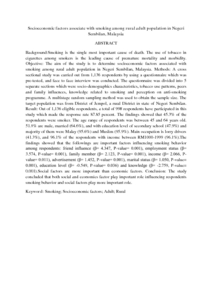Citation
Ajan, Rubiahanak and Juni, Muhamad Hanafiah and Minhat, Halimatus Sakdiah and Mahmud, Aidalina
(2016)
Socioeconomic factors associate with smoking among rural adult population in Negeri Sembilan, Malaysia.
International Journal of Public Health and Clinical Sciences, 3 (3).
pp. 122-131.
ISSN 2289-7577
Abstract
Background: Smoking is the single most important cause of death. The use of tobacco in cigarettes among smokers is the leading cause of premature mortality and morbidity. Objective: The aim of the study is to determine socioeconomic factors associated with smoking among rural adult population in Negeri Sembilan, Malaysia. Methods: A cross sectional study was carried out from 1,136 respondents by using a questionnaire which was pre-tested, and face to face interview was conducted. The questionnaire was divided into 5 separate sections which were socio-demographics characteristics, tobacco use patterns, peers and family influences, knowledge related to smoking and perception on anti-smoking programme. A multistage random sampling method was used to obtain the sample size. The target population was from District of Jempol, a rural District in state of Negeri Sembilan. Result: Out of 1,136 eligible respondents, a total of 998 respondents have participated in this study which made the response rate 87.85 percent. The findings showed that 45.3% of the respondents were smoker. The age range of respondents was between 45 and 64 years old. 51.8% are male, married (64.6%), and with education level of secondary school (47.9%) and majority of them were Malay (95.6%) and Muslim (95.9%). Main occupation is lorry drivers (41.3%), and 96.1% of the respondents with income between RM1000-1999 (96.1%).The findings showed that the followings are important factors influencing smoking behavior among respondents: friend influence (β= 4.347, P-value= 0.001), employment status (β= 3.574, P-value= 0.001), family member (β= 2.123, P-value= 0.001), income (β= 2.066, P-value= 0.011), advertisement (β= 1.452, P-value= 0.001), marital status (β= 1.050, P-value= 0.001), education level (β= -0.549, P-value= 0.036) and knowledge (β= -2.759, P-value= 0.001).Social factors are more important than economic factors. Conclusion: The study concluded that both social and economics factor play important role influencing respondents smoking behavior and social factors play more important role.
Download File
![[img]](http://psasir.upm.edu.my/53839/1.hassmallThumbnailVersion/Socioeconomic%20factors%20associate%20with%20smoking%20among%20rural%20adult%20population%20.pdf)  Preview |
|
PDF
Socioeconomic factors associate with smoking among rural adult population .pdf
Download (74kB)
| Preview
|
|
Additional Metadata
Actions (login required)
 |
View Item |

